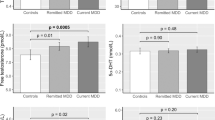Abstract
Epidemiological and clinical studies support the view that aggressive acts like suicidal and violent behaviors share a common substrate. Certain aspects of violence in males have been related to high testosterone levels, but the relation of testosterone to attempted suicide has not been studied until now. We estimated plasma levels of testosterone (T), LH, and FSH in 80 male subjects after a suicide attempt and in whom a psychiatric assessment was done during their hospitalization. Suicide intent was evaluated in 72 subjects. A group of 56 healthy males in the same age range served as control. As a group, attempters showed significantly lower T levels, marginally higher LH, and normal FSH compared to controls. The attempters who used violent methods (26 subjects) had T levels even lower than the non-violent (drug overdose) subgroup. Comparisons of T levels of subgroups according to the (main) drug ingested (analgesics, benzodiazepines, antidepressants, neuroleptics, or other drugs) did not reveal any significant drug effect. In relation to diagnosis, the lowest T levels were found in the subgroup with schizophrenia (29 subjects). The T levels of this subgroup were also significantly lower compared to those of a group of 31 male schizophrenic patients, hospitalized and treated with neuroleptics. If the influence of post-attempt stress and medical condition on plasma T could be ruled out, low plasma T may prove to be a biological predictor of attempt, at least in male schizophrenic patients. Nevertheless, the findings differentiate suicidal behavior from other aggressive/violent behaviors and do not support the notion that suicidal and aggressive behaviors are manifestations of the same impulse.



Similar content being viewed by others
References
Litman R (1967) Sigmund Freud on suicide. In: Shneidman E (ed) Essays in self-destruction. Science House, New York, pp 324–344
Lester D (1968) Suicide as an aggressive act. J Gen Psychol 79:83–86
Miotto P, De Coppi M, Frezza M, Petretto D, Masala C, Petri A (2003) Suicidal ideation and aggressiveness in school-aged youths. Psychiatry Res 120:247–255
Horesh N, Gothelf D, Ofek H, Weizman T, Apter A (1999) Impulsivity as a correlate of suicidal behavior in adolescent psychiatric inpatients. Crisis 20:8–14
Schneider B, Wetterling T, Sargk D, Schneider F, Schnabel A, Maurer K, Fritze J (2006) Axis I disorders and personality disorders as risk factors for suicide. Eur Arch Psychiatry Clin Neurosci 256:17–27
Engstrom G, Persson B, Levander S (1999) Temperament traits in male suicide attempters and violent offenders. Eur Psychiatry 14:278–283
Kalin NH (1999) Primate models to understand human aggression. J Clin Psychiatry 60(Suppl 15):S29–S32
Virkkunen M, Rawlings R, Tokola R, Poland RE, Guidotti A, Nemeroff C, et al. (1994) CSF biochemistries, glucose metabolism and diurnal activity rhythms in alcoholic violent offenders, fire setters and healthy volunteers. Arch Gen Psychiatry 51:20–27
Brooks JH, Reddon JR (1996) Serum testosterone in violent and nonviolent young offenders. J Clin Psychol 52:475–483
Banks T, Dabbs JM (1996) Salivary testosterone and cortisol in a delinquent and violent urban subculture. J Soc Psychol 136:49–56
Higley JD, Mehlman PT, Poland RE, Taub DM, Vickers J, Suomi SJ, et al. (1996) CSF testosterone and 5-HIAA correlate with different types of aggressive behaviors. Biol Psychiatry 40:1067–1082
Simon NG, Cologer-Clifford A, Lu SF, McKenna SE, Hu S (1998) Testosterone and its metabolites modulate 5HT1A and 5HT1B agonist effects on intermale aggression. Neurosci Behav Rev 23:325–336
Stefulj J, Buttner A, Kubat M, Zill P, Balija M, Eisenmenger W, Bondy B, Jernej B (2004) 5HT-2C receptor polymorphism in suicide victims. Association studies in German and Slavic populations. Eur Arch Psychiatry Clin Neurosci 254:224–227
Evans J, Reeves B, Platt H, Leibenau A, Goldman D, Jefferson K, Nutt D (2000) Impulsiveness, serotonin genes and repetition of deliberate self-harm (DSH). Psychol Med 30:1327–1334
Butterfield MI, Stechuchac KM, Connor KM, Davidson JRT, Wang C, Mackuen CL, et al. (2005) Neuroactive steroids and suicidality in posttraumatic stress disorder. Am J Psychiatry 162:380–382
Thiblin I, Runeson B, Rajs J (1999) Anabolic androgenic steroids and suicide. Ann Clin Psychiatry 11:223–231
Gustavsson G, Traskman-Benz L, Higley JD, Westrin A (2003) CSF testosterone in 43 male suicide attempters. Eur Neuropsychopharmacol 13:105–109
Beck AT, Beck R, Kovacks M (1975) Classification of suicidal behaviors. I Quantifying intent and lethality. Am J Psychiatry 132:182–187
Markianos M, Hatzimanolis J, Lykouras L (1999) Switch from neuroleptics to clozapine does not influence pituitary-gonadal axis hormone levels in male schizophrenic patients. Eur Neuropsychopharmacol 9:533–536
Zitzmann M, Nieschlag E (2001) Testosterone levels in healthy men and the relation to behavioral and physical characteristics: facts and constructs. Eur J Endocrinol 144:183–197
Elman I, Breier A (1997) Effects of acute metabolic stress on plasma progesterone and testosterone in male subjects: relationship to pituitary-adrenocortical axis activation. Life Sci 61:1705–1712
Spratt DJ, Cox P, Orav J, Moloney J, Bigos T (1993) Reproductive axis suppression in acute illness is related to disease severity. J Clin Endocrinol Metab 76:1548–1554
Brown AS, Hembree WC, Friedman JH, Kaufmann CA, Gorman JM (1995) The gonadal axis in men with schizophrenia. Psychiatry Res 28:231–239
Kaneda Y, Kavamura I, Fugii A, Ohmori T (2004) Impact of switch from typical to atypical antipsychotic drugs on quality of life and gonadal hormones in male patients with schizophrenia. Neuroendocrinol Lett 25:135–140
Mann JJ, Currier D, Stanley B, Oquendo MA, Amsel LV, Ellis SP (2006) Can biological tests assist prediction of suicide in mood disorders? Int J Neuropsychopharmacol 9:465–474
Author information
Authors and Affiliations
Corresponding author
Rights and permissions
About this article
Cite this article
Tripodianakis, J., Markianos, M., Rouvali, O. et al. Gonadal axis hormones in psychiatric male patients after a suicide attempt. Eur Arch Psychiatry Clin Neurosci 257, 135–139 (2007). https://doi.org/10.1007/s00406-006-0686-y
Received:
Accepted:
Published:
Issue Date:
DOI: https://doi.org/10.1007/s00406-006-0686-y




